Working with the Smithsonian Institution, the Conservancy for Tibetan Art & Culture organized the largest exhibition of Tibetan culture ever held in the West — with over one million visitors attending “Tibetan Culture Beyond the Land of Snows,” the centerpiece of the Smithsonian’s Folklife Festival, held in the millennium year of 2000 on the National Mall in Washington, DC.
A highlight of the 10-day festival was an offering — for the first time ever in the West — of the Monlam Chenmo, the traditional “Great Prayer Festival” celebrated annually in Lhasa, Tibet for 550 years.

After leading the Monlam Chenmo and its prayers for world peace, the Dalai Lama faced the Capitol and addressed an audience of 50,000 people on the National Mall, stressing the right and wish of all beings to enjoy happiness and overcome suffering. Following his talk, His Holiness delivered a lengthy message in Tibetan for the benefit of Radio Free Asia and the Voice of America who were carrying the event live.
More than one million visitors were able to directly experience many different aspects of Tibetan culture — including a hands-on chance to turn a traditional Tibetan prayer wheel — in front of the U.S. Capitol in Washington, DC during the ten-day “Tibetan Culture Beyond the Land of Snows,” exhibition organized by the Conservancy for Tibetan Art & Culture working with the Smithsonian Institution.
A direct encounter with a dynamic, living culture
An in-depth exploration of Tibetan culture, Tibetan Culture Beyond the Land of Snows afforded a rare opportunity for the public to meet and hear directly from Tibetan refugees living in exile in India and in the United States and elsewhere. Throughout the Festival, visitors were able to speak with Tibetans from many different backgrounds, learn about their lives and their livelihoods, watch them work — including some of the finest traditional artists and thangkha painters now living outside Tibet, musicians from Canada and California, craftspeople from Dharamsala, cooks from the United States, carpet weavers from Nepal, traditional Tibetan physicians, master storytellers, calligraphers — and even yak herders — as well as watch Tibetan monks create a traditional Tibetan sand mandala, and perform sacred music and sacred dance.
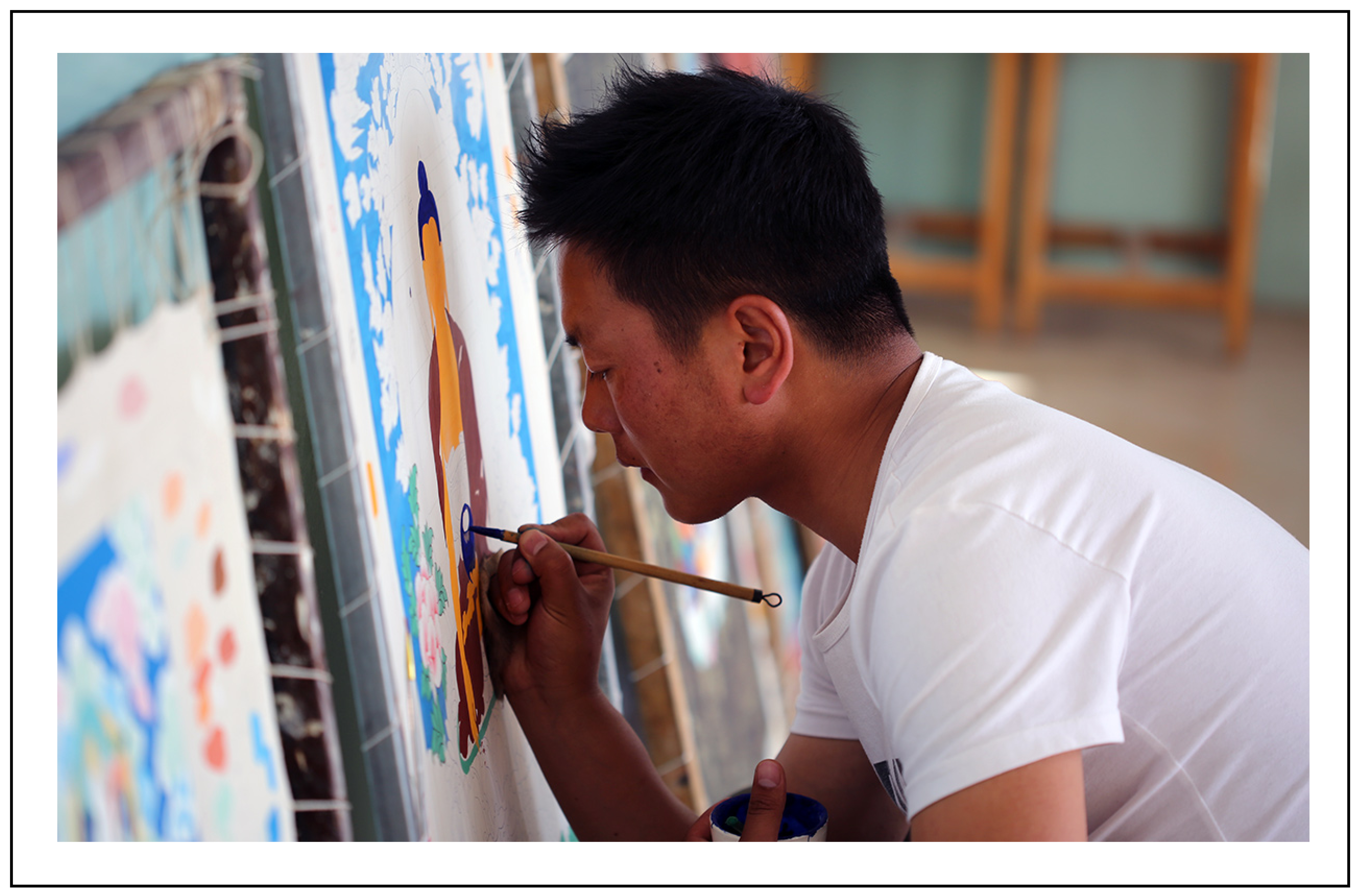
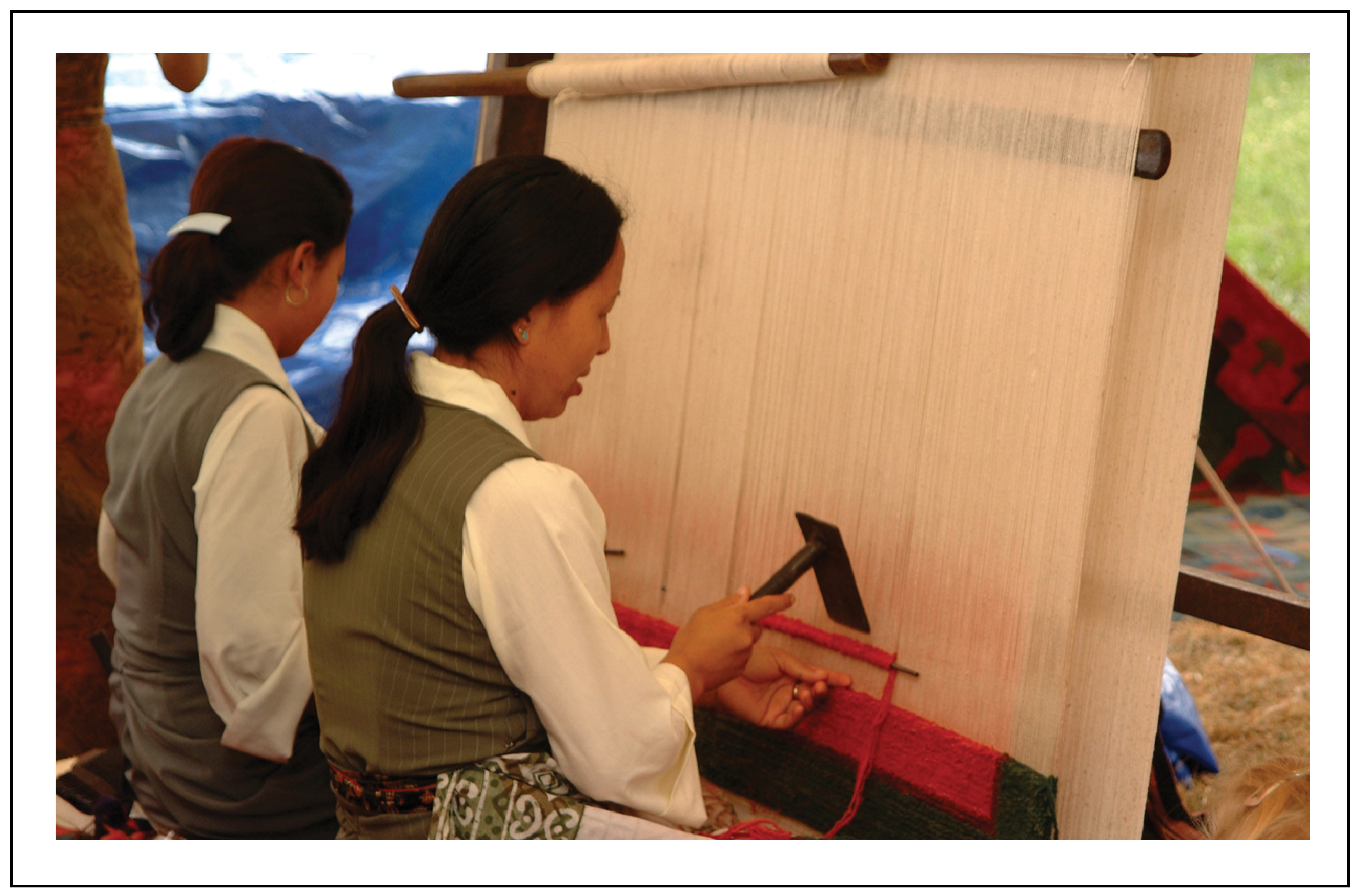

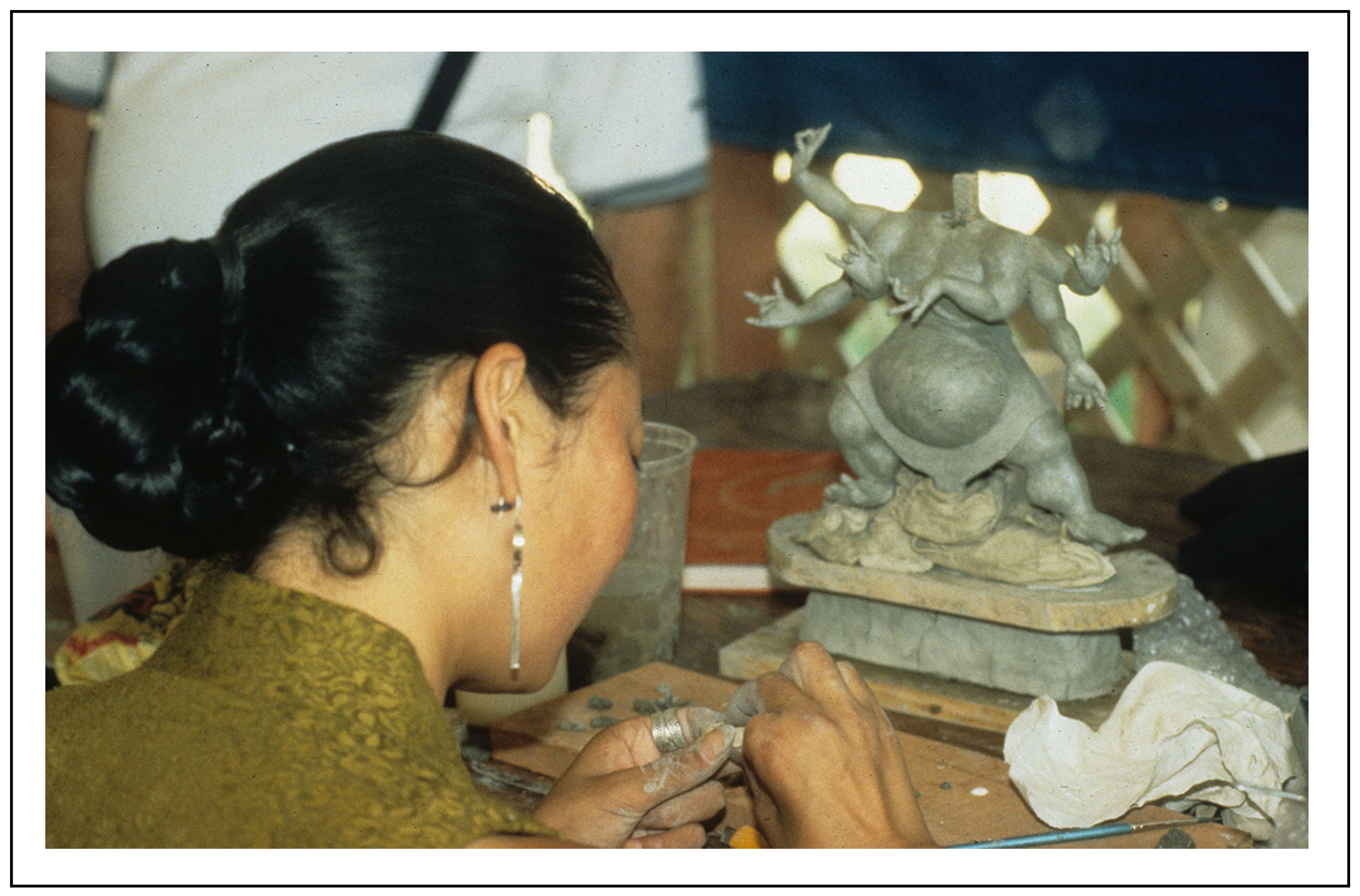
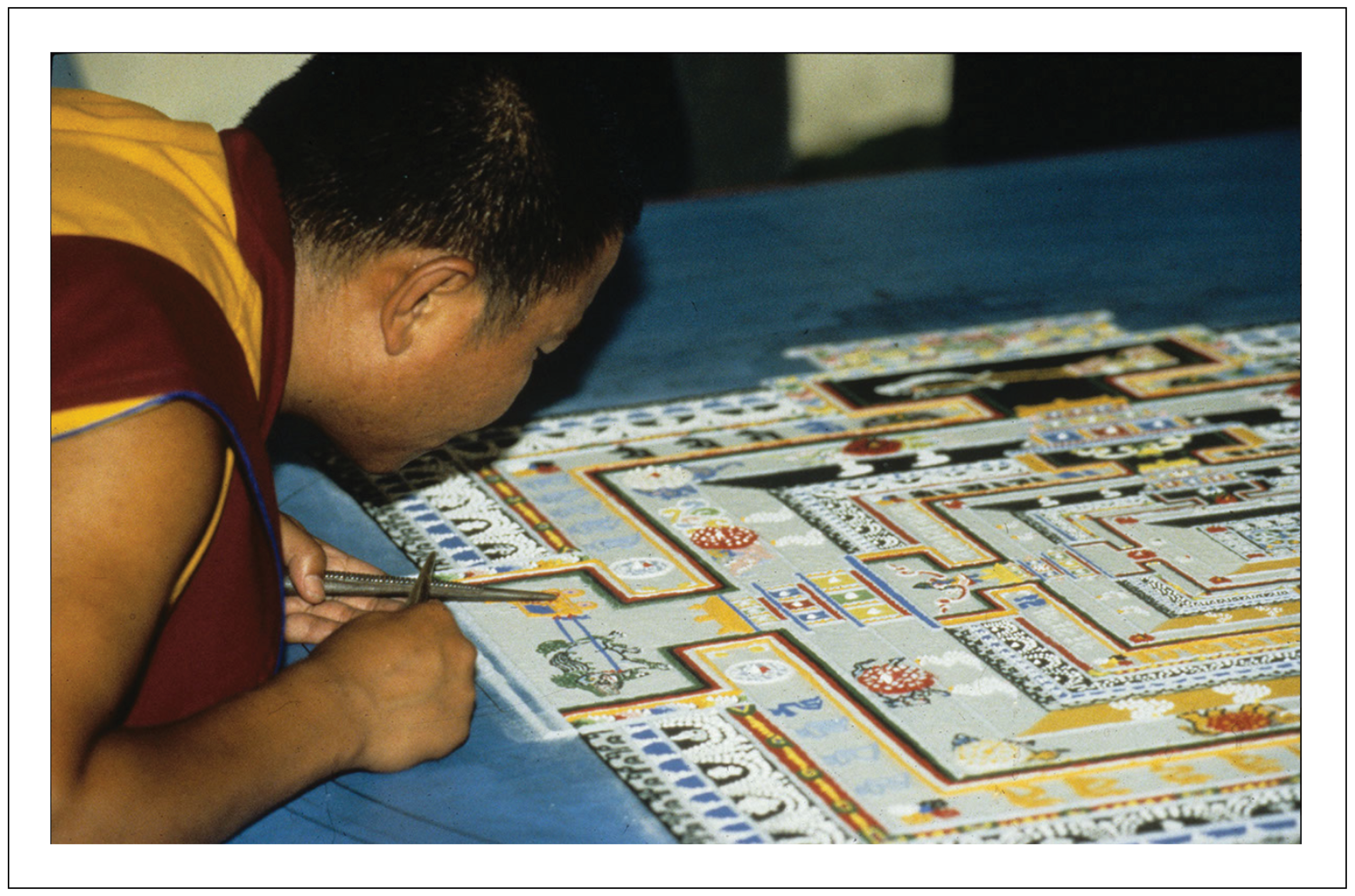
(from top to bottom) a Tibetan thangkha painter; Tibetan carpet weavers from Nepal; members of the Tibetan Institute of Performing Arts (TIPA) performing traditional Tibetan Opera; Tibetan artist creating a sculpture; and, a Tibetan monk creating a traditional Tibetan sand mandala during the “Tibetan Culture Beyond the Land of Snows” exhibition at the Smithsonian’s 34th Folklife Festival in Washington, DC.
The largest Tibetan cultural event ever held in the West
Free and open to the public, Tibetan Culture Beyond the Land of Snows was the largest Tibetan cultural event ever held in the West, bringing together participants from a dozen countries — included chanting monks and singing nuns, paper and doll makers, metal smiths, yak herders, dancers and singers.
Going far beyond the boundaries of a static art exhibit or performance, Tibetan Culture Beyond the Land of Snows was a research-based presentation of the living traditions of Tibetan communities in exile, bringing more than one million visitors into a direct, unprecedented encounter with the breadth and depth of a dynamic, living culture — from watching master artists in action, to watching monks debate philosophy, and hearing teachers from the Tibetan Bon tradition as well as from the four schools of Tibetan Buddhism — including hearing from the leaders of two of those schools: the 14th Dalai Lama and the 41st Sakya Trizin.
From these experiences and discussions, Festival visitors gained a clearer understanding of the rich legacy and complex history of Tibetan culture, as well as the threats to its survival in the twenty-first century. Indeed, Tibetan Culture Beyond the Land of Snows provided a platform for Tibetans to speak for themselves, and paint a more complete picture of Tibetan culture — not just as some historical ideal or museum-worthy relic from an ancient time, or as a “Shangri-la” of the Western imagination — but as a living reality for a widespread, ethnically-diverse, contemporary cultural community. This gave visitors a chance to gain a deeper understanding of how critical a role culture plays in shaping the identities of both a refugee community and a nation.
Some Festival participants, for instance, were able to tell of their own experiences of loss, torture, death and exile, and the harmful effects of the cultural destruction suffered in the wake of the brutal Chinese invasion and occupation of Tibet — while others spoke to how Buddhist insights developed by Tibetan masters over centuries into highly sophisticated intellectual reflections and meditation practices were important to their daily lives, and vital to the survival of Tibetan culture.
History of the Monlam Chenmo
First celebrated in the year 1409 by the Tibetan monk and philosopher Tsongkhapa, the Monlam Chenmo commemorates the Buddha’s enlightenment. Over time, the Monlam Chenmo and its offering of prayers grew to become the Tibetan year’s central cultural event — a solemn yet joyous celebration held annually for 550 years in Lhasa, Tibet, until the Chinese invasion and occupation of Tibet.
At its height, the Monlam Chenmo would be held over a period of 21 days, as 20,000 to 30,000 monks participated in sessions of prayers, chanting, religious teachings and philosophical debate.
Today, among Tibetan refugees, the Monlam Chenmo begins a few days after Losar (Tibetan New Year) and normally lasts five days. On the final day of the celebration in Dharmasala, India, seat of the Tibetan government-in-exile, the Dalai Lama presides over the ceremony and gives religious teachings. In the evening, large butter sculptures are displayed amidst tens of thousands of butter lamps offered and lit by pilgrims.
An unforgettable experience
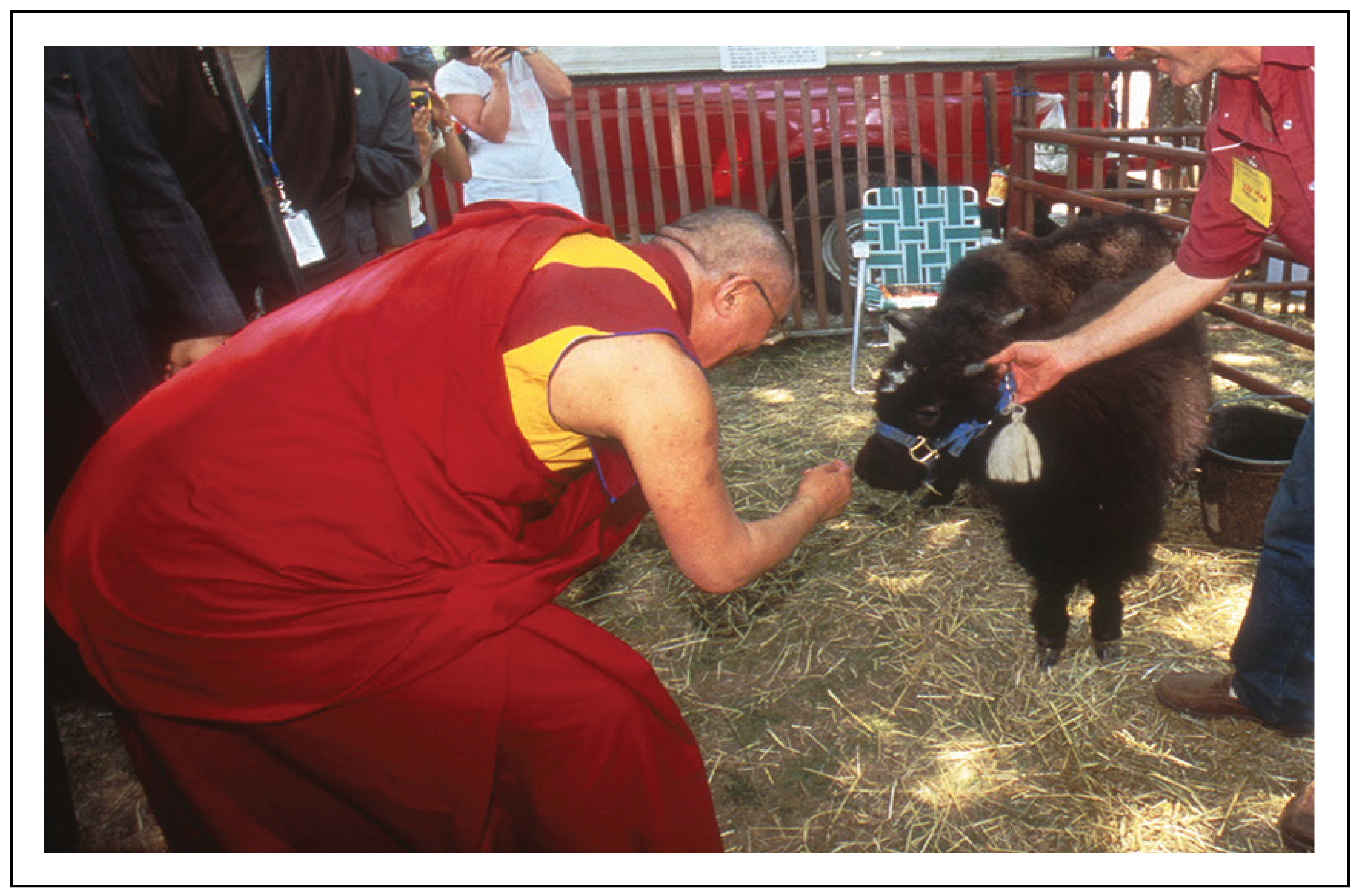
The Dalai Lama took everyone by surprise when he made an unscheduled visit to the Festival, coming to meet every one of the 140 Tibetans craftsmen, artisans, monastics, and musicians working at the Festival — even taking time to stop and visit with the three Tibetan yaks grazing in the shade on the National Mall, bringing smiles to the faces of Festival visitors who watched and listened as the Dalai Lama chanted mantras into the ears of two of the yak calves.
Tibetan Culture Beyond the Land of Snows was an unforgettable experience — for the organizers as well as attendees. The kind of experiences and memories created at the Festival are captured in these words from one of the principal workers who helped to organize the Festival:
“Of the two weeks of events at the Festival — dancing, singing, craftsmanship, talks, and demonstrations — there were two highlights that remain vivid in my mind’s eye.
“The first was nearing the end when some of the Festival staff and volunteers, along with a handful of local Tibetans, planned a candle vigil around the stūpa (reliquary) that had been constructed on the National Mall. What began as a few volunteers with votive candles quickly turned into a couple hundred complete strangers working in silent unison lighting candles and arranging them not only around the stūpa, but also throughout the entire venue the size of a football field.
“As dusk fell, the evening was illuminated with over 10,000 candles, lit in friendship and peace, bonding people of all nationalities, some praying, some chanting mantras, others remaining with a deep smile.”
“As the evening drew to a close, Tibetans thanked everyone who took part and asked them to pray for those who are living under harsh conditions in Tibet, that they may find peace and freedom. Magic happened that evening on the National Mall.” — Matteo Pistono, Conservancy for Tibetan Art & Culture
Tibetan Culture Beyond the Land of Snows was produced by the Smithsonian Center for Folklife and Cultural Heritage, in collaboration with the Conservancy for Tibetan Art & Culture, with the support of more than 1,400 individuals and foundations, and assistance from many Tibetan communities and their members from throughout the world, including the volunteer efforts of the members of the Capital Area Tibetan Association.
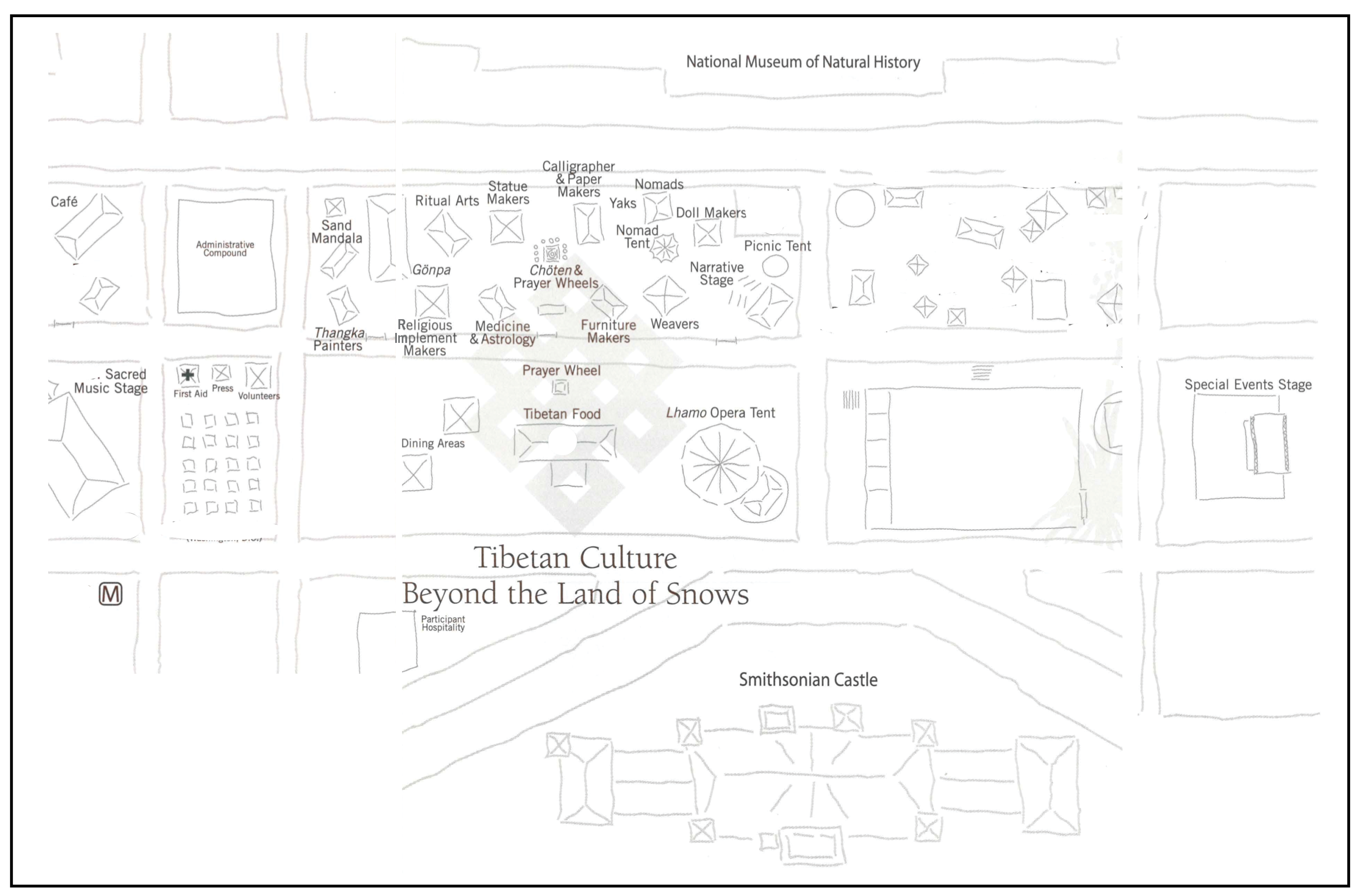
A map showing the exhibit area — including the chorten, prayer wheel and gonpa, opera tent, sand mandala tent, nomad tent, Tibetan medicine tent, yak area, food tents and other areas — of the “Tibetan Culture Beyond the Land of Snow” exhibition, located in between the National Museum of Natural History and the Smithsonian Castle, at the heart of the Smithsonian Folklife Festival on the National Mall in Washington, DC.
THANKS
Tibetan Culture Beyond the Land of Snows would not have been possible without the the assistance of His Holiness the 14th Dalai Lama of Tibet and the Tibetan government-in-exile, major support from the Tibet Fund, Tibet House New York, The Rockefeller Foundation, The Gere Foundation, Steven and Barbara Rockefeller, The Shelley and Donald Rubin Foundation — as well as the participation, help and support of the following individuals:
Center for Folklife and Cultural Heritage
Richard Kurin, Director
Richard Kennedy, Deputy Director
Diana Parker, Festival Director
Curators: Richard Kennedy, Jamphel Lhundup
Conservancy for Tibetan Art & Culture
Program Coordinators: Matthew Pistono (U.S.), Tenpa Samkhar (India)
Program Associate: Marni Kravitz
Program Assistants: Tashi Choepel (India), Carolyn Hengst (U.S.)
Coordinating Committee in India: Tenpa Samkhar, Kalon Tempa Tsering, Kim Yeshi
PARTICIPANTS:
CRAFT TRADITIONS
Mohammed Yusuf Bhutia, traditional hat maker, Kalimpong, India
Tashi Dolma, traditional apron weaver, Dharamsala, India
Samdup Dhargyal, carpet weaver, New York
Awang Dorjee, stone carver, Dharamsala, India
Kelsang Dorjee, sculptor/mask maker/painter, Dharmasala, India
Penpa Dorjee, sculptor/metal worker, Dharamsala, India
Ven. Yeshi Dorjee, thangka painter, Rowland Heights, CA
Ven. Sangey Hishey, thankga painter, Dharamsala, India
Ven. Samten Jigme, doll maker, Dharamsala, India
Samten Lama, paper maker, Kathmandu, Nepal
Chhiring Yuden Lamini, traditional weaver, Kathmandu, Nepal
Norbu, woodcarver, Dharamsala, India
Tsering Norbu, incense maker, Panipat, India
Pekar, sculptor/painter, Dharamsala, India
Choe Phuntsok, sculptor/woodcarver, Dharamsala, India
Nimto Sherpa, paper maker, Kathmandu, Nepal
Soga, craftsman/religious implements Dehra Dun, India
Thanley, tailor, Dharamsala, India
Ven. Hishey Thomey, tailor, Dharamsala, India
Topey, nomadic skills/craftsperson, Ladakh, India
Lekshek Tsering, printer/wood-block carver, Tashijong, India
Penpa Tsering, sculptor/ metaI worker, Dharamsala, India
Ven. Phuntsok Tsering, applique thangka artist, Dharamsala, India
Tsering Tsomo, nomadic skills/craftsperson, Ladakh, India
Lobsang Yarphel, carpet weaver/yarn maker, Kathmandu, Nepal
FOODWAYS TRADITIONS
Pema Rabgey, traditional Tibetan cook, Seattle, WA
OCCUPATIONAL TRADITIONS
Dawa Dolma, Doctor of Tibetan Medicine, Dharamsala, India
Jhurme, religious storyteller, Dehra Dun, India
Tashi Lhamo, Doctor of Tibetan Medicine, Dharamsala, India
Phurbu Tsering, traditional Tibetan astrologer, Dharamsala, India
Ngawang Choedak Zingshuk, calligrapher, Bylakuppe Tibetan Settlement, India
PERFORMING ARTS TRADITIONS
Loten Namling, musician/singer, Utzigen, Switzerland
Bylakuppe Lhamo (Opera) Troupe, Bylakuppe Tibetan Settlement, India
Thinlay Gonpo
Namgyal Chonzom
Lobsang Gyatso
Lhagoe
Namdol
Ngudup
Thupten Pema
Lhakpa Sichoe
Sonam Tenzin
Thupten
Sonam Topgyal
Dawa Tsamchoe
Namgyal Tseten
Namgyal Yangzom
Pema Chodon Zomkey
Tashi Dhondup, Pacifica, CA
Tenzin Gonpo, Paris, France
Nyima Gyalpo, Berkeley, CA
Tsering Topgyal, Dharamsala, India
Tenzin Wangdak, Brooklyn, NY
Tibetan Institute of Performing Arts Dharmasala, India
Tenzin Choedon
Lobsang Choephel
Tashi Dhargyal
Samten Dhondup
Tashi Dhondup
Tseten Dolker
Namgyal Dolma
Phuntsok Dolma
Gombo Dorjee
Tsering Dorjee
Passang Lhamo
Tseten Lhundup
Tsering Lodoe
Tenzin Ngedhen
Tenzin Ngawang
Tsering Paldon
Ngodup Paljor
Lobsang Samten
Tsewang
RITUAL ART TRADITIONS
Namgyal Monastery, Dharamsala, India
Ven. Tenzin Kalsang
Ven. Tenzin Kunchok
Ven. Tenzin Legmon
Ven. Tenzin Norbu
Ven. Tenzin Norgyal
Ven. Tenzin Phuntsok
Ven. Tenzin Samten
Ven. Ngawang Tashi
Ven. Tenzin Thapkhey
Ven. Ngawang Tsundu
Ven. Tenzin Wangchuk
Ven. Thupten Woesar
Drepung Loseling Monastery, Atlanta, GA and Mungod, India
Ven . Zangra Tulku
Ven. Lathing Tulku
Ven. Gangkar Tulku
Ven. Geshe Tsepak Dorje
Ven. Geshe Pema Norbu
Ven. Geshe Sonam Dhondup
Ven. Geshe Yeshe Chodup
Ven. Geshe Dakpa Kelsang
Ven. Geshe Thubten Wangyal
Ven . Ngawang Tashi Bapu
Ven. Geshe Thubten Dorje
Ven. Yeshe Sherab
Ven. Geshe Dakpa Tenzin
Ven. Geshe Thubten Jamyang
Ven. Geshe Takpa Jigmed
Ven. Geshe Thupten Choejor
Ven. Agha Tenzin Legdup
Ven. Lobsang Tsultrim
Ven. Tenzin Legden
Ven. Lobsang Tenzin
Ven. Phuntsok Tsondu
Ven. Ngawang Tsultrim
Ven. Thupten Lobsang
Ven. Pema Wangden
Ven. Wangden Tashi
Ven. Dondup Tenzin
Ven. Kelsang Dorje
Ven. Lobsang Phurbu
Ven. Passang Gelek
Pal Shenten Menri Ling Bon Monastery Solan, India
Chongtul Rinpoche
Ven. Samdrup Dorji
Tibetan Nuns Project/ Shugsep Nunnery Dharamsala, India
Ven. Ogyen Dolma
Ven. Ogyen Tsundu
SUPPORTERS
In addition to those mentioned above, major support for Tibetan Culture Beyond the Land of Snows was provided by Kazuko Tatsumura Hillyer, Inner Harmony Wellness Center/Peter Amato, the International Campaign for Tibet, the Kruglak Family, Edward F Nazarko, Padma Health Products, the Tibetan Alliance of Chicago, and the Utah Tibet Support Group.
The Conservancy for Tibetan Art & Culture would also like to express its thanks to all of the following who helped make Tibetan Culture Beyond the Land of Snows possible — as well as to all of the Festival workers and supporters whose names might not appear here, but whose help, support and hard work made Beyond the Land of Snows possible.
PATRONS
Asian Cultural Council, Terrance Carlson and Jeanette Leehr, Grant Couch, Brian Kistler, Alex Lowe Charitable Foundation, Gaylord Neely, Vera Pratt, gYung-Drung Bon Temple Foundation.
ARTIST SPONSORS
Lourdes Arguelles and Anne Rivero, Marge Cellini, Young-Hwi Chang, Ling Chen, Ted Lee Fisher, Randall Gates, Marge Knutson, Ivan Kruglak and Natacha Kruglak, Elizabeth Hamlin, Heron Foundation, Dr. Lorianne Masuoka, Myoren Louise Hagihara/Dharma Center Bookstore, Stephanie Odegard, Joseph Pattison, Sandra Ross and Martin Resnick, Julia and John Thornton, Tibetan Association of New York & New Jersey, Mark Vaughan, Lisa A. Yacoubian.
FESTIVAL SUPPORTERS
Wendy Appel; Dianne Armstrong-Delorenzo; Linda Beutner; Elizabeth Bjorklund; James and Rachel Blankenship; John Blaxall; Rose Marsh Boyle; Raffi Cavoukian; Kathleen Crawford; Michelle De Cou-Landberg; Dianne F Doherty; Patricia Earhart; Laurence Eggers; Robert Farina; Susan Getzendanner; Good Works Foundation; Dr. Robin C. Hyman and Dr. Christine A. Hyman; Nita Ing; Alexandra Isles; Bryce and Juli Jasmer; MarkJoyce; Susan Lantz; Bart Leonard and Barbara Krumsiek; Los Angeles Friends of Tibet; Toni McOmber; Dr. Bobbi Nassar; Barbara Nicol; Northwest Tibetan Cultural Association; Linda Pessemier; Robert Pogue; Regional Tibetan Youth Congress of New York and New Jersey; Marlene Reiss; Stanford and Dorothy Ross; Elizabeth Sackler; David and Ellie Sambol; Lyle Sanford; Jesse Sartain; Steven Schwartz; Ben and Fredericka Shapiro; Geshe Lhundup Sopa; Tibetan American Foundation of Minnesota; Tibetan Association of Boston; Tibetan Association of Minnesota; Tibetan Association of Southern California; Tibetan Community of Alberta; Alicia Vogel; Barry Wagner; Lucy Weed; Kathleen Sinclair Wood; Margarida Wu.
IN-KIND CONTRIBUTORS
Arnold &: Porter, Washington, DC; Capital Area Tibetan Association, Washington, DC; Roger Craver, Falls Church, VA; Carol Dean, Washington, DC; Drepung Loseling Institute, Atlanta, GA; Carole Elchert, Findlay, OH; Susan England, Washington, DC; Don Farber, Santa Monica, CA; Luke Fretwell, Alexandria, VA; Brian Harris, Vancouver, BC; Himalayan Art Project, New York, NY; Bob King, Boulder, CO; Paul Kloppenburg, Crestone, CO; Mandala, Soquel, CA; Julie Meling, Chilmark, MA; Daniel Miller, Washington, DC; Merrick Morton, Los Angeles, CA; Namgyal Monastery, Dharamsala, India; The Newark Museum, Newark, NJ; Norbulingka Institute, Sidhpur, India; Kalsang Lodoe Oshoe, Springfield, MA; Odegard, Inc., New York, NY; Douglas Pearce, Washington, DC; Losang Rabgey, Washington, DC; Betty Rogers, Washington, DC; Samaya Foundation, New York, NY; SEVA Service Society, Vancouver, BC; Shambhala Sun, Halifax, NS; William Shuyler, Alexandria, VA; John Simpson, Springfield, MA; Snow Lion Publications, Ithaca, NY; Philip Sugden, Findlay, OH; University of Massachusetts at Amherst, Amherst, MA; David Urubshurow, Chevy Chase, MD; Wisdom Publications, Somerville, MA; Alison Wright, San Francisco, CA; Sonam Zoksang, New York, NY.
SPECIAL THANKS
All our Festival volunteers; John Ackerly; Bruce Adams; Amnye Machen Institute; Conrad Anker; Lisa Arakaki; Chieko Ariga; Asian Classics Institute; Pamela Atkinson; Mojgone Azemun; Laura Beldiman; Howard Berkes; Bob Bissland; Black Diamond Company; Richard Blum; Gary Blythe; David Breashears; Robyn Brentano; Mark Brinkerhoff; Thad Brown; Bureau of His Holiness the Dalai Lama, New Delhi; Patrick Calderoni; Capital Area Tibetan Association; Lisa Caterino; Central Tibetan Administration (CTA); Topjor and Perna Chagzoetsang; Hannah Chismar; Tenzing Choedak; Perna Chozom; Conservancy for Tibetan Art & Culture Board of Directors; Cecily Cook; Jeff Cox; Mark Croghan; Crossing Over Consortium, Inc. dba Paper Road/Tibet; Nancy Dadok; Michelle DeCou-Landberg; Deer Park Buddhist Center & Monastery; Dekyi Larsoe Tibetan Settlement; Phurbu Sithar Dekhang; Department of Education (CTA); Department of Finance (CTA); Department of Home (CTA); Department of Information and International Relations (CTA); Department of Religion and Culture (CTA); Ven. Lobsang Dechen; Rinchen Dharlo; Dhondenling Tibetan Settlement; Tsering Dhondup; Tenzin Dhongthog; Dickyiling Tibetan Settlement; Dr. Tenzin Dingyon; Doeguling Tibetan Settlement; Perna Dolma; Chodon and Dhondup Dorji; Tsering Dorji; Drepung Loseling Monastery; Greg Durgin; Dzi Tibet Collection; Barbara Falconer; Caroline Finnegan; Foothill Oriental Rug Store; Melissa Mathison and Harrison Ford; Linda Frees; Lesley Friedell; Gelek Rinpoche; Richard Gere; Barbara and Michael Goldstein; Jennifer Greenfield; Nagdol and Tashi Gyaltsen; Lodi G. Gyari; Joel Gysan; Paul Hackett; Hampden and Wheeler Galleries; Amy Head; John Hocevar; James Hopkins; Jeffrey Hopkins; International Campaign for Tibet; jewel Heart; The Right Reverend Bishop Carolyn Tanner Irish; Dr. Thupten Jinpa; Jeanne Johnson; Nancy Jo johnson; Kalsang Yugial Jorkhang; Kashag Office; Vivian Kurz; Lome Ladner; Gabrielle Lafitte; Kathy Lahitz; Richard and Mary Lanier; Land of Compassion Buddha; Marilee Latta; Steve Lehman; Tenzin Lhakey; Library of Tibetan Works & Archives; Judy Lin; L. T. Litho, Colorado Springs; Little America Hotel; Jonathan Lower; Lugsung Samdupling Tibetan Settlement; Rick Mandhal; Brent Manning; Manning Curtis & Bradshaw Bednar Law Firm; Mary Beth Markey; Steve Marshall; Melvin McCloud; Mac McCoy; Ambassador John W McDonald; Tim McNeil; Peter Metcalf; Daniel Miller; Judy Mitoma; Sophijoye Mosko; Namgyal Monastery; Elizabeth Napper; Norbulingka Institute; Jamling Norgay; T. N. Norpa; O.C. Tanner Company; Office of His Holiness the Dalai Lama; Office of Tibet, New York; Ayako Okada; Pal Shenten Menri Ling Monastery, Dolanji; Yeshe Pelgye; Theresa Perrone; Tseten Phanucharas; Sidney Piburn; Potala Tours & Travels; Losang Rabgey; Dr. Ngawang Rabgyal; Rabgyeling Tibetan Settlement; The Henry and Anne Reich Family Foundation; Valrae Reynolds; Matthieu Ricard; Rigpa Fellowship; Sue Roche; Diana Rose; Debra Ross; Mark Rovner; Katherine and Rob Rowley; Salt Lake Episcopal Diocese; Arlene Samen; Kyle Samperton; Tenzin Thogmey Sampho; Ralph Samuelson; San Diego Friends; Tashi Sangmo; Nina Schroeder; Sego Gallery; Jeff Sells; Josh Silver; Nina Smith; Warren Smith; Smithsonian Office of Horticulture; Smithsonian Office of Special Events and Conference Services; Missy Snelling; Snow Bird Ski Resort; Sogyal Rinpoche; Bob Springmeyer; Larry and Tracy Stevens; Wayne Su; Geshe Lobsang Tenzin; Kalan T. C. Tethong; Tenzin Thongdol; Thubten Dhargye Ling; Nena v. S. Thurman; Robert A. F Thurman; Tibet Fund; Tibet House New York; Tibetan Alliance of Chicago, Inc.; Tibetan Association of Utah; Tibetan Crafts Community, Tashi Jong; Tibetan Institute of Performing Arts ; Tibetan Medical and Astra Institute; Tibetan Nuns Project; Tibetan Refugee Health Care Project; Tibetan Welfare Office, Simla; Kalan Sonam Topgyal; Tsa-Tsa Factory; Bhuchung K Tsering; Former Representative Kasur Dawa Tsering; Lhasang Tsering; Chetue Penpa Tsering; Kalan Tempa Tsering; David Urubshurow; Elisa Marie Vanderhooft; Ven. Nicky Vreeland; Darrell Weaver; Eric Wilden; Kathy & Ted Wilson; James W Wohlgemuth; Dr. Marcia Woolf; Leslie Wong; Phil Wykle; xpedx Paper Company; Kim and Kalsang Yeshi; Tenzin Zangma.
